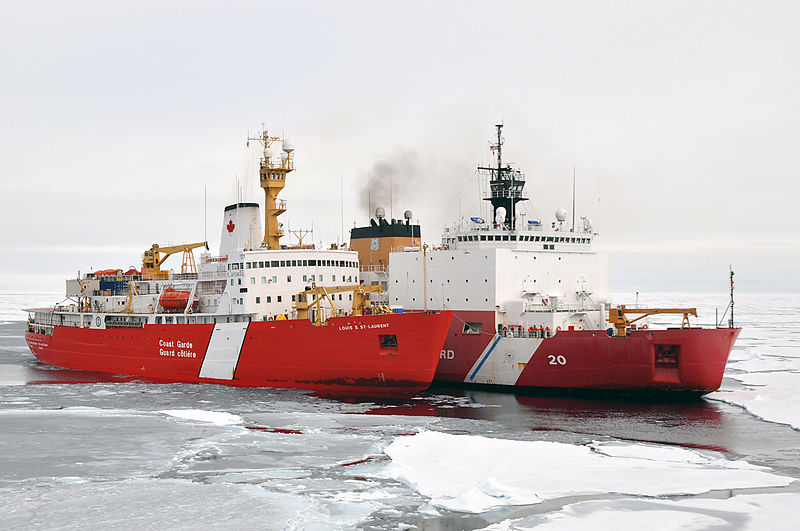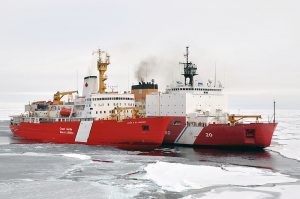
This is a guest post by Alexandra Reay.
 In the past 40 years, the Arctic sea ice extent maximums and minimums have gotten increasingly smaller. Sea ice loss is happening, and it’s going to leave its mark on the planet. Some of the effects of the sea ice loss are higher temperatures, raising the sea levels, endangering the polar bears, and various natural disasters.
In the past 40 years, the Arctic sea ice extent maximums and minimums have gotten increasingly smaller. Sea ice loss is happening, and it’s going to leave its mark on the planet. Some of the effects of the sea ice loss are higher temperatures, raising the sea levels, endangering the polar bears, and various natural disasters.
As the sea ice is melting, we can’t ignore the fact that new shipping routes in the Arctic will be available. Specialists believe that by the end of the 21-century, new Arctic shipping routes can be established and become ready to use in case they’re approved.
With no further ado, in this post, we’re discussing what sea ice loss means for the Arctic Ocean in terms of new opportunities and environmental concerns, both of which can affect Arctic shipping.
Global Warming
Sea ice melting will only accelerate global warming because of the albedo effect. As Jenifer Denver, HR manager at writing geeks explained, “The albedo effect is the simple concept that the white surfaces help at keeping the planet cool, reflecting the most of the Sun’s energy back into space while dark surfaces absorb almost all the heat from the Sun.”
Therefore, less ice, less bright surfaces, and a darker sea are aspects that lead to higher temperatures. So, based on the cause-and-effect principle, global warming goes hand in hand with sea ice loss. According to research, the albedo effect is already responsible for 25% of global warming.
Sea Level Rise
Ice is nothing else but frozen water, so as it keeps melting it contributes to the water level of the ocean. Since sea ice floats and its pressure contributes to the sea level, it will take some time until its melting will contribute to the rising of the sea level.
It’s the land-based ice from Greenland that once it melts instantly contributes to the sea level rise. According to scientists’ estimations, if all of Greenland’s level-based ice melts, which is almost three times bigger than Texas, the sea levels will rise about 20 feet.
Greenland’s melting ice has already contributed to the rising of the sea levels 4%, and the numbers keep rising at an accelerated rate. In the US, flooding is starting to be a problem, especially in New Jersey, Florida, and Maryland.
More Extreme Weather
Every change in nature is coming with its consequences and so is sea ice loss. There are scientists who are certain that sea ice loss is going to have its effects on the weather and proof is already here.
For instance, one article research presents that when the temperature of the Arctic is too warm, the eastern US is threatened with extreme winter weather. As well, eastern US already experienced freezing temperatures that broke the records. The signs are already here, but there’s still a lot more to debate.
What Will Sea Ice Loss Mean for Arctic Shipping?
While the sea ice melting and the increasing temperatures of the sea levels are good signs for the Arctic shipping, the extreme water may present some concerns in the future. Anyway, one thing is for sure:
According to the sea ice melting rates, by the end of the 21-century, specialists will be able to define new, safe, and faster shipping routes through the Arctic Ocean. They have already estimated that the routes will be 40% shorter, which will make shipping faster while the fuel consumption will be significantly reduced.
As well, this will mean that Arctic shipping routes will be of interest for more countries, so here’s where economic and political interests strike. As Steven White, the web developer of essaygeeks.co.uk, stated, “What we cannot deny is that the sea ice loss can really improve the Arctic shipping in many ways, from reduced fuel consumption to faster shipments.”
Conclusion
With all of this being said, sea ice loss means shorter and faster routes for Arctic shipping since new and safe routes will be available by the end of the century, considering that the maximum extent of Arctic sea ice is lower and lower as the years pass by. But the decision of using the new forming routes on the Arctic is not ours to make. There will be economical and political conflicts that will dictate their usability.
Related Articles
Germany & Iceland Arctic Shipping Cooperation Good News for U.S.
Watch Out International Shipping, Antarctica is Falling Apart!
China is Shipping Through the Arctic!
Maersk Sending First Container Ship Through Arctic
Pack Up Santa, We’re Shipping Thru the North Pole!
Freight News: China Shipping Breakthrough Could Lower Freight Rates
Ocean Freight Emissions Have Caused Global Cooling?
This was a guest post by Alexandra Reay.
Author Bio
Alexandra Reay is an editor and professional writer at essayontime.com. She is also a regular contributor to myassignmentwriting.com.au. Alexandra is fond of horse-riding, reading, and rock music. Alexandra keeps her spirit in writing fluent articles as well.
Discover more from reviewer4you.com
Subscribe to get the latest posts to your email.






